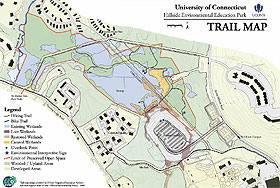  |
| HOME | THIS ISSUE | CALENDAR | GRANTS | BACK ISSUES | < BACK | NEXT > |
Event to celebrate landfill transformationby Richard Veilleux - October 14, 2008 |
||||
| The transformation of a once toxic landfill into a serene environmental landscape complete with trails, boardwalks, and rookeries will be celebrated at a noontime event on Oct. 21. “The work that’s been done here is nothing short of remarkable,” says UConn President Michael J. Hogan who, along with Regina McCarthy, commissioner of the state Department of Environmental Protection (DEP), and Mansfield Mayor Elizabeth Paterson, will speak at the celebration of the site’s transformation. “The DEP had legitimate concerns about the site and I’m glad we were able to work with them to meet environmental standards and, in fact, to surpass them. Not only was the site remediated, but trails were cut, wetlands restored, and educational signs posted. “This will be a wonderful spot for students and faculty to conduct research, for community members to enjoy an afternoon stroll, and for nature to reclaim an area it once owned,” Hogan adds. The site, located between North Hillside and Hunting Lodge roads, was used as a landfill from 1966 to 1989. It was also used as a dump for toxic materials, including laboratory chemicals, solvents, pesticides, and herbicides, from 1966 to 1987. In 1998, the DEP stepped in and issued a consent order for the University to clean up and properly close the facility. The DEP is pleased with the University’s efforts. “The University of Connecticut has taken positive steps to address some long-standing environmental challenges by completing the proper cleanup of areas once used for the disposal of waste, refuse, and various chemicals,” says Commissioner McCarthy. “UConn has not only turned these areas into useful space but has also created a new nature preserve that will be used as an outdoor classroom and an area for the public to enjoy. This project is an example of how to turn problems associated with outdated past practices into learning opportunities for the next generation.” Now, 10 years after the consent order was issued, the work is completed. The former landfill has been capped, and a new 500-space parking lot (C-Lot), accessible from North Hillside Road, sits atop the site. But the most remarkable aspect of the work sits just to the north of the area: the 64-acre Hillside Environmental Education Park (HEEP).
The park includes more than two miles of hiking trails, and more than 30 acres of wetlands. During the work, several contaminated wetlands were restored and several others created. A vernal pool was developed, which will support amphibians such as wood frogs and spotted salamanders. There is at least one Great Blue Heron nest remaining from a rookery that UConn officials hope will be re-established this year, and a Great Horned Owl has been spotted recently. Sections of boardwalk and two overlook decks allow for hiking and bird watching. The park’s trails connect with others to leverage the amount of open space now accessible to hikers, joggers, and nature lovers, says Richard Miller, director of the Office of Environmental Policy. One example is a trail that connects, across Hunting Lodge Road, with a trail through the town-owned Shelter Falls Park. “This is a UConn tale of trash to treasure,” says Miller, “We’ve remediated the damage caused by the former chemical pits on the site, communicated with townspeople throughout the process, and created a refuge that people will enjoy for years to come.” The layout was developed by Professor Kristin Schwab’s senior landscape design students, who determined how to make the most of the hilly site and where to connect the trails, place signs to educate visitors, and maximize observation of ecosystems, plants, and wildlife. “The University has done an excellent job,” says Mansfield Mayor Betsy Paterson. “There were a few hurdles in the beginning, but University officials kept everybody informed every step of the way. I’m delighted with the end result.” |
| ADVANCE HOME UCONN HOME |

